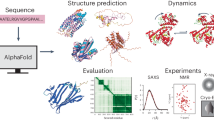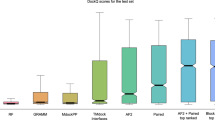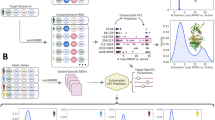Abstract
Therapeutic peptides represent the forefront of drug discovery, offering potent and safe alternatives to traditional small molecules. However, their weak and context-dependent nature complicates the efficient virtual screening and structural characterization of protein–peptide patterns. Here we introduce RAPiDock, a diffusion generative model designed for rational, accurate and rapid protein–peptide docking at an all-atomic level. RAPiDock efficiently reduces the sampling space by incorporating physical constraints and uses a bi-scale graph to effectively capture multidimensional structural information while balancing efficiency. In addition, the model uses a Clebsch–Gordan tensor product-based architecture to ensure physical symmetry. RAPiDock outperforms existing tools in prediction of protein–peptide-binding patterns, achieving a 93.7% success rate at top-25 predictions (13.4% higher than AlphaFold2-Multimer), with an execution speed of 0.35 seconds per complex (~270 times faster than AlphaFold2-Multimer). Extensive experiments demonstrate RAPiDock’s remarkable ability to handle 92 types of residue including posttranslational modifications, accurately predict subtle docking patterns, successfully identify multiple potential peptide-binding sites in global docking and serve as a powerful tool for high-throughput virtual screening with structural precision. All these push the boundaries of efficient protein–peptide docking in multiple real-application scenarios.
This is a preview of subscription content, access via your institution
Access options
Access Nature and 54 other Nature Portfolio journals
Get Nature+, our best-value online-access subscription
$32.99 / 30 days
cancel any time
Subscribe to this journal
Receive 12 digital issues and online access to articles
$119.00 per year
only $9.92 per issue
Buy this article
- Purchase on SpringerLink
- Instant access to full article PDF
Prices may be subject to local taxes which are calculated during checkout






Similar content being viewed by others
Data availability
The processed datasets, as well as pretrained models, are available via Zenodo at https://doi.org/10.5281/zenodo.14193621 (ref. 77). Unbound protein–peptide complexes were taken from the PepSet benchmark package (http://cadd.zju.edu.cn/pepset/statics/binaryDownload/benchmark.tar.gz). Source data are provided with this paper.
Code availability
The source code of this study is freely available via GitHub at https://github.com/huifengzhao/RAPiDock and Zenodo at https://doi.org/10.5281/zenodo.14568726 (ref. 78).
References
Stein, A. & Aloy, P. Contextual specificity in peptide-mediated protein interactions. PLoS ONE 3, e2524 (2008).
Babu, M. M., van der Lee, R., de Groot, N. S. & Gsponer, J. Intrinsically disordered proteins: regulation and disease. Curr. Opin. Struct. Biol. 21, 432–440 (2011).
Wright, P. E. & Dyson, H. J. Intrinsically disordered proteins in cellular signalling and regulation. Nat. Rev. Mol. Cell Biol. 16, 18–29 (2015).
Petsalaki, E. & Russell, R. B. Peptide-mediated interactions in biological systems: new discoveries and applications. Curr. Opin. Biotechnol. 19, 344–350 (2008).
Muttenthaler, M., King, G. F., Adams, D. J. & Alewood, P. F. Trends in peptide drug discovery. Nat. Rev. Drug Discov. 20, 309–325 (2021).
Wang, L. et al. Therapeutic peptides: current applications and future directions. Signal Transduct. Target. Ther. 7, 48 (2022).
Kumar, V. B. et al. Peptide self-assembled nanocarriers for cancer drug delivery. J. Phys. Chem. B 127, 1857–1871 (2023).
La Manna, S., Di Natale, C., Onesto, V. & Marasco, D. Self-assembling peptides: from design to biomedical applications. Int. J. Mol. Sci. 22, 12662 (2021).
Li, L., Chen, X., Yu, J. & Yuan, S. Preliminary clinical application of RGD-containing peptides as PET radiotracers for imaging tumors. Front. Oncol. 12, 837952 (2022).
Zhou, Y. et al. Molecularly stimuli-responsive self-assembled peptide nanoparticles for targeted imaging and therapy. ACS Nano 17, 8004–8025 (2023).
Sharma, K., Sharma, K. K., Sharma, A. & Jain, R. Peptide-based drug discovery: current status and recent advances. Drug Discov. Today 28, 103464 (2023).
Vadevoo, S. M. P. et al. Peptides as multifunctional players in cancer therapy. Exp. Mol. Med. 55, 1099–1109 (2023).
Dai, M. Y. et al. High-potency PD-1/PD-L1 degradation induced by peptide-PROTAC in human cancer cells. Cell Death Dis. 13, 924 (2022).
Nhàn, N. T. T., Yamada, T. & Yamada, K. H. Peptide-based agents for cancer treatment: current applications and future directions. Int. J. Mol. Sci. 24, 12931 (2023).
Lee, A. C., Harris, J. L., Khanna, K. K. & Hong, J. H. A comprehensive review on current advances in peptide drug development and design. Int. J. Mol. Sci. 20, 2383 (2019).
Caporale, A., Adorinni, S., Lamba, D. & Saviano, M. Peptide-protein interactions: from drug design to supramolecular biomaterials. Molecules 26, 1219 (2021).
Ciemny, M. et al. Protein-peptide docking: opportunities and challenges. Drug Discov. Today 23, 1530–1537 (2018).
Zhou, P., Jin, B., Li, H. & Huang, S. Y. HPEPDOCK: a web server for blind peptide-protein docking based on a hierarchical algorithm. Nucleic Acids Res. 46, W443–W450 (2018).
de Vries, S. J., Rey, J., Schindler, C. E. M., Zacharias, M. & Tuffery, P. The pepATTRACT web server for blind, large-scale peptide-protein docking. Nucleic Acids Res. 45, W361–W364 (2017).
Alam, N. et al. High-resolution global peptide-protein docking using fragments-based PIPER-FlexPepDock. PLoS Comput. Biol. 13, e1005905 (2017).
Zhang, Y. & Sanner, M. F. AutoDock CrankPep: combining folding and docking to predict protein-peptide complexes. Bioinformatics 35, 5121–5127 (2019).
Trellet, M., Melquiond, A. S. & Bonvin, A. M. A unified conformational selection and induced fit approach to protein-peptide docking. PLoS ONE 8, e58769 (2013).
Xu, X., Yan, C. & Zou, X. MDockPeP: an ab-initio protein-peptide docking server. J. Comput. Chem. 39, 2409–2413 (2018).
Zhang, X. et al. Efficient and accurate large library ligand docking with KarmaDock. Nat. Comput. Sci. 3, 789–804 (2023).
Weng, G. et al. Comprehensive evaluation of fourteen docking programs on protein–peptide complexes. J. Chem. Theory Comput. 16, 3959–3969 (2020).
Jumper, J. et al. Highly accurate protein structure prediction with AlphaFold. Nature 596, 583–589 (2021).
Tsaban, T. et al. Harnessing protein folding neural networks for peptide-protein docking. Nat. Commun. 13, 176 (2022).
Evans, R. et al. Protein complex prediction with AlphaFold-Multimer. Preprint at bioRxiv https://doi.org/10.1101/2021.10.04.463034 (2022).
Shanker, S. & Sanner, M. F. Predicting protein–peptide interactions: benchmarking deep learning techniques and a comparison with focused docking. J. Chem. Inf. Model. 63, 3158–3170 (2023).
Johansson-Åkhe, I. & Wallner, B. Improving peptide-protein docking with AlphaFold-Multimer using forced sampling. Front. Bioinform. 2, 959160 (2022).
Wu, R. et al. High-resolution de novo structure prediction from primary sequence. Preprint at bioRxiv https://doi.org/10.1101/2022.07.21.500999 (2022).
Bret, H., Gao, J., Zea, D. J., Andreani, J. & Guerois, R. From interaction networks to interfaces, scanning intrinsically disordered regions using AlphaFold2. Nat. Commun. 15, 597 (2024).
Abramson, J. et al. Accurate structure prediction of biomolecular interactions with AlphaFold 3. Nature 630, 493–500 (2024).
Ge, J. et al. Deep-learning-based prediction framework for protein-peptide interactions with structure generation pipeline. Cell Rep. Phys. Sci. 5, 101980 (2024).
Wang, Z. et al. Comprehensive evaluation of ten docking programs on a diverse set of protein–ligand complexes: the prediction accuracy of sampling power and scoring power. Phys. Chem. Chem. Phys. 18, 12964–12975 (2016).
Mondal, A., Chang, L. & Perez, A. Modelling peptide–protein complexes: docking, simulations and machine learning. QRB Discov. 3, e17 (2022).
Ramachandran, G. T. & Sasisekharan, V. Conformation of polypeptides and proteins. Adv. Protein Chem. 23, 283–437 (1968).
Liu, Z., Sun, Q. & Wang, X. PLK1, a potential target for cancer therapy. Transl. Oncol. 10, 22–32 (2017).
Śledź, P. et al. From crystal packing to molecular recognition: prediction and discovery of a binding site on the surface of Polo-like kinase 1. Angew. Chem. Int. Ed. 50, 4003–4006 (2011).
Lin, T.-Y. et al. Design, synthesis and biological evaluation of phosphopeptides as Polo-like kinase 1 Polo-box domain inhibitors. Bioorg. Med. Chem. 26, 3429–3437 (2018).
Elia, A. E. et al. The molecular basis for phosphodependent substrate targeting and regulation of PLKs by the Polo-box domain. Cell 115, 83–95 (2003).
Diop, A. et al. SH2 domains: folding, binding and therapeutical approaches. Int. J. Mol. Sci. 23, 15944 (2022).
Neduva, V. & Russell, R. B. Peptides mediating interaction networks: new leads at last. Curr. Opin. Biotechnol. 17, 465–471 (2006).
Marasco, M. & Carlomagno, T. Specificity and regulation of phosphotyrosine signaling through SH2 domains. J. Struct. Biol. X 4, 100026 (2020).
Asmamaw, M. D., Shi, X.-J., Zhang, L.-R. & Liu, H.-M. A comprehensive review of SHP2 and its role in cancer. Cell. Oncol. 45, 729–753 (2022).
Lange, A. et al. Classical nuclear localization signals: definition, function, and interaction with importin α. J. Biol. Chem. 282, 5101–5105 (2007).
Goswami, R. et al. Nuclear localization signal-tagged systems: Relevant nuclear import principles in the context of current therapeutic design. Chem. Soc. Rev. 53, 204–226 (2024).
Joglekar, A. V. & Li, G. T cell antigen discovery. Nat. Methods 18, 873–880 (2021).
Shen, Y., Parks, J. M. & Smith, J. C. HLA class I supertype classification based on structural similarity. J. Immunol. 210, 103–114 (2023).
Trott, O. & Olson, A. J. AutoDock Vina: improving the speed and accuracy of docking with a new scoring function, efficient optimization, and multithreading. J. Comput. Chem. 31, 455–461 (2010).
Zhang, O. et al. Learning on topological surface and geometric structure for 3D molecular generation. Nat. Comput. Sci. 3, 849–859 (2023).
Hampton, J. T. & Liu, W. R. Diversification of phage-displayed peptide libraries with noncanonical amino acid mutagenesis and chemical modification. Chem. Rev. 124, 6051–6077 (2024).
Zhu, X., Lopes, P. E., Shim, J. & MacKerell, A. D. Jr Intrinsic energy landscapes of amino acid side-chains. J. Chem. Inf. Model. 52, 1559–1572 (2012).
Malathy Sony, S. M., Saraboji, K., Sukumar, N. & Ponnuswamy, M. N. Role of amino acid properties to determine backbone tau(N-Calpha-C’) stretching angle in peptides and proteins. Biophys. Chem. 120, 24–31 (2006).
Tien, M. Z., Sydykova, D. K., Meyer, A. G. & Wilke, C. O. PeptideBuilder: a simple Python library to generate model peptides. PeerJ 1, e80 (2013).
Xiong, X., Zhou, B. & Wang, Y. G. Graph representation learning for interactive biomolecule systems. Preprint at https://arxiv.org/abs/2304.02656 (2023).
Isinkaye, F. O., Folajimi, Y. O. & Ojokoh, B. A. Recommendation systems: principles, methods and evaluation. Egypt. Inform. J. 16, 261–273 (2015).
Deng, C. et al. Vector neurons: a general framework for SO(3)-equivariant networks. Proc. IEEE/CVF Int. Conf. Comput. Vis. 2021, 12200–12209 (2021).
Thomas, N. et al. Tensor field networks: rotation- and translation-equivariant neural networks for 3D point clouds. Preprint at https://arxiv.org/abs/1802.08219 (2018).
Kondor, R., Lin, Z. & Trivedi, S. Clebsch–Gordan nets: a fully Fourier space spherical convolutional neural network. In Advances in Neural Information Processing Systems (eds Bengio, S. et al.) (Curran Associates, 2018).
Han, J., Rong, Y., Xu, T. & Huang, W. Geometrically equivariant graph neural networks: a survey. Preprint at https://arxiv.org/abs/2202.07230 (2022).
Corso, G., Stärk, H., Jing, B., Barzilay, R. & Jaakkola, T. S. DiffDock: diffusion steps, twists, and turns for molecular docking. In Proc. International Conference on Learning Representations (ICLR, 2023); https://openreview.net/forum?id=kKF8_K-mBbS
Nikolayev, D. I. & Savyolov, T. I. Normal distribution on the rotation group SO(3). Texture Stress Microstruct. 29, 201–233 (1997).
Chaudhury, S., Lyskov, S. & Gray, J. J. PyRosetta: a script-based interface for implementing molecular modeling algorithms using Rosetta. Bioinformatics 26, 689–691 (2010).
Jing, B., Corso, G., Chang, J., Barzilay, R. & Jaakkola, T. Torsional diffusion for molecular conformer generation. Adv. Neural Inf. Process. Syst. 35, 24240–24253 (2022).
Rose, P. W. et al. The RCSB Protein Data Bank: integrative view of protein, gene and 3D structural information. Nucleic Acids Res. 45, D271–D281 (2017).
Madhavi Sastry, G., Adzhigirey, M., Day, T., Annabhimoju, R. & Sherman, W. Protein and ligand preparation: parameters, protocols, and influence on virtual screening enrichments. J. Comput. Aided Mol. Des. 27, 221–234 (2013).
Salomon‐Ferrer, R., Case, D. A. & Walker, R. C. An overview of the Amber biomolecular simulation package. Wiley Interdiscip. Rev. Comput. Mol. Sci. 3, 198–210 (2013).
Méndez, R., Leplae, R., De Maria, L. & Wodak, S. J. Assessment of blind predictions of protein–protein interactions: current status of docking methods. Proteins 52, 51–67 (2003).
Basu, S. & Wallner, B. DockQ: a quality measure for protein-protein docking models. PLoS ONE 11, e0161879 (2016).
Lensink, M. F., Nadzirin, N., Velankar, S. & Wodak, S. J. Modeling protein‐protein, protein‐peptide, and protein‐oligosaccharide complexes: CAPRI 7th edition. Proteins 88, 916–938 (2020).
Zhang, Y., Forli, S., Omelchenko, A. & Sanner, M. F. AutoGridFR: improvements on AutoDock affinity maps and associated software tools. J. Comput. Chem. 40, 2882–2886 (2019).
Jones, G., Willett, P., Glen, R. C., Leach, A. R. & Taylor, R. Development and validation of a genetic algorithm for flexible docking. J. Mol. Biol. 267, 727–748 (1997).
Zhang, Y. & Skolnick, J. Scoring function for automated assessment of protein structure template quality. Proteins 57, 702–710 (2004).
Kabsch, W. & Sander, C. DSSP: definition of secondary structure of proteins given a set of 3D coordinates. Biopolymers 22, 2577–2637 (1983).
Shrake, A. & Rupley, J. A. Environment and exposure to solvent of protein atoms. Lysozyme and insulin. J. Mol. Biol. 79, 351–371 (1973).
Zhao, H. RAPiDock. Zenodo https://doi.org/10.5281/zenodo.14193621 (2024).
Zhao, H. huifengzhao/RAPiDock: RAPiDock_v1.1. Zenodo https://doi.org/10.5281/zenodo.14568726 (2024).
Acknowledgements
This study was financially supported by the National Key R&D Program of China (grant number 2024YFA1307501 to T.H.), National Natural Science Foundation of China (grant number 82373791 to Y.K.), National Natural Science Foundation of China (grant number 22220102001 to T.H.), National Natural Science Foundation of China (grant number 22307112 to D.J.) and the Young Scientists Fund of Natural Science Foundation of Hunan Province of China (grant number 2025JJ60651 to D.J.). We thank the Information Technology Center and State Key Laboratory of CAD&CG, Zhejiang University.
Author information
Authors and Affiliations
Contributions
Y.K., T.H., H.Z. and O.Z. designed the research study. H.Z. developed the method and wrote the code. H.Z., O.Z., D.J., Z.W., H.D., X.W., Y.Z., Y.H. and J.G. performed the analysis. H.Z., Y.K., T.H. and O.Z. wrote the paper. All authors read and approved the paper.
Corresponding authors
Ethics declarations
Competing interests
The authors declare no competing interests.
Peer review
Peer review information
Nature Machine Intelligence thanks Irina Hashmi and the other, anonymous, reviewer(s) for their contribution to the peer review of this work.
Additional information
Publisher’s note Springer Nature remains neutral with regard to jurisdictional claims in published maps and institutional affiliations.
Extended data
Extended Data Fig. 1 Effects of various factors on the docking performance of RAPiDock in the RefPepDB-RecentSet (compared to AF2Multi_RS).
(a) shows the effect of peptide lengths. (b) shows the effect of ASA%. (c) shows the effect of different second structures. Secondary structure categorization follows DSSP standards: ‘Loop’ includes Turn, Bend, and Coil; ‘Helix’ encompasses 310 helix, π helix, and α helix; ‘PPII’ is defined as polyproline II helix; ‘Strand’ covers beta bridge and strand structures. The box plots show the 25–75% confidence intervals (box limits), the median (centre line), and the 5–95% confidence intervals (whiskers). Green triangles indicate the mean values. N values report the number of clusters in each band.
Extended Data Fig. 2 Superior local and global docking performance of RAPiDock on more challenging tasks.
(a-c) illustrate the Top N success rates of various methods based on the CAPRI-peptide standards. Solid lines represent local docking approaches, while dashed lines represent global docking ones, (d-f) show the Top1, Top5 and Top25 success rates of various methods. The bars above the dashed line represent the performance of local docking approaches, while the bars below show that of global docking approaches. According to CAPRI-peptide standards, three accuracy levels are considered, namely Acceptable Quality (a and d), Medium Quality (b and e), and High Quality (c, f).
Extended Data Fig. 3 The docking performance of RAPiDock on SHP2.
(a) The sequences of 5X7B (N-SH2 domain of SHP2) and 5X94 (C-SH2 domain of SHP2). (b) left: The overlay of protein residues of 5X7B and 5X94. In SH2 domains, two structural regions determine the PpI: (1) the phosphotyrosine binding site, a groove-like structure formed by the αA helix, βB/βC/βD strands, and BC loop, and (2) the specificity pocket, which is a relatively large hydrophobic pocket mainly delimited by residues of αB helix, βD strand, and BG and EF loops. The phosphotyrosine binding site is relatively conserved, whereas the specificity pocket is more flexible; right: the peptides of 5X7B and 5X94 share a common 7-residue sequence PIpYATID. Given the pTyr residue serving as a reference, the residues from −2 to +3 align well in the pocket. The residues at +4 of the peptides exhibit obvious deviation, influenced by structural differences in the protein near the BG loop. Specifically, the proteins of 5X7B and 5X94 are colored green and yellow, respectively, while their peptides are colored white and gray, respectively. (c) Top-ranked peptide conformation generated by RAPiDock for 5X7B. (d) Top- ranked peptide conformation generated by RAPiDock for 5X94. The peptide conformations generated by RAPiDock are colored coral red.
Supplementary information
Supplementary Information
Supplementary Notes 1–8, Figs. 1–37 and Tables 1–10.
Source data
Source Data Fig. 2
Statistical source data.
Source Data Fig. 3
Statistical source data.
Source Data Fig. 6
Statistical source data.
Source Data Extended Data Fig. 1
Statistical source data.
Source Data Extended Data Fig. 2
Statistical source data.
Rights and permissions
Springer Nature or its licensor (e.g. a society or other partner) holds exclusive rights to this article under a publishing agreement with the author(s) or other rightsholder(s); author self-archiving of the accepted manuscript version of this article is solely governed by the terms of such publishing agreement and applicable law.
About this article
Cite this article
Zhao, H., Zhang, O., Jiang, D. et al. Protein–peptide docking with a rational and accurate diffusion generative model. Nat Mach Intell 7, 1308–1321 (2025). https://doi.org/10.1038/s42256-025-01077-9
Received:
Accepted:
Published:
Issue date:
DOI: https://doi.org/10.1038/s42256-025-01077-9



